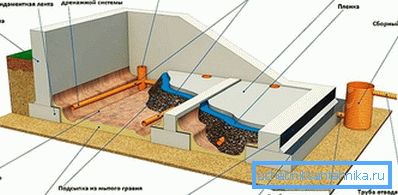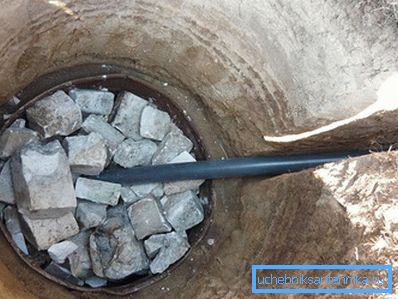How to make drainage around the house
Private household requires care. Without proper protection and maintenance, a house could collapse in a few years. Therefore, even before the start of construction, we should consider the insulation and facing of the house, the protection of the foundation and much more. One of the systems that contributes to the long life of the house is drainage. It ensures the removal of excess moisture from the foundation of buildings. This is what this article will be about.
What is a drainage system for?

Flooded basements, dampness in the rooms, the appearance of mold and the gradual destruction of the walls - this is only a small list of problems that arise if there is no drainage system on the site.
During precipitation or during the period of snow melting, water begins to creep up to the house. If the site is located in a valley, or underground water is located close to the surface, then flooding cannot be avoided. And, as a result, we get a lot of problems. Therefore, even at the construction stage it is necessary to think over the system of water drainage.
Drainage around the house can be done after the completion of construction work, and in some cases such a system may be even more effective. Having lived a year in the house, the owner will be able to notice the most dangerous areas and take into account the features of the terrain when designing the drainage system.
Draw up a scheme

The first thing you need to do before you start laying the system is to make a diagram. Without a well-thought-out plan, drainage efficiency will be low. There are the following types of such systems:
- ring or trench;
- wall mount
Which scheme will be used depends on the characteristics of the soil and the relief of the site. Ring drainage is used where sandy soil is present. It is a closed system that diverts water into a well or off-site.
Elements of the ring system should be located no closer than 3 m from the walls of structures. If you violate these rules, it is possible the subsidence of the soil, as well as damage to the foundation and walls of the house.
Ring systems are created in the event that the house has no basements. In the opposite case, it is better to build a wall system. Such a system is located 0.5 m from the foundation of the building. It is also a closed system of water lines.

In both cases, when turning the pipes, it is necessary to equip manholes. They will allow you to monitor the operation of the system and clean the conduits if necessary. In addition, you should consider ways to drain water outside the site. Since the drainage well is installed at the lowest point, it may sometimes be necessary to install a special pump for pumping accumulated water.
What is needed for the arrangement of the drainage system?

This is a rather painstaking and time-consuming task. For arrangement of water drainage you will need:
- To carry out the excavation work, prepare the shovels and call an assistant. You can order a small excavator service from a specialized company. This will speed up the work, but will require additional financial costs.
- Perforated pipes, called conduits or drains. Today on sale you can find a large selection of such pipes. The most commonly used products are plastic, polyethylene or polypropylene. For the drainage system you need to choose pipes with a diameter of 100 mm.
- Various connecting elements. Such products will be needed to make the system bends at different angles.
- The drainage system must be equipped with manholes. They are installed in places of pipe rotation and on long straight sections. Wells are necessary to control the operation of the system and remove blockages. Such designs can be made independently of concrete or buy ready-made plastic products. The latter option will require additional costs, but it will significantly facilitate the operation of the entire system.
- In order for the perforated holes of the conduits not to become clogged with soil, it is necessary to equip the drainage layer and filter. To do this, you will need sand, fine crushed stone or gravel, as well as a geotextile canvas.
- Various measuring devices. It is better to purchase a laser level, as well as stock up on a set of poles and cord. All this is needed when creating the slope of pipes.
And, of course, stock up with diligence and perseverance.
The drainage system will be located in the ground. It is necessary to do everything right the first time, as correctional work will require additional labor and financial costs.
Laying drainage

After the scheme of the future drainage is made, we proceed to marking the system on the ground. After that we do all the earthworks. It is necessary to dig trenches for pipe laying. At the same time the necessary bias is adjusted to the side of the well. It is recommended to observe a slope of 2 cm per meter of pipe. This will ensure the unobstructed flow of water collected by the system.
Then a cushion under the pipe is made. For this, the entire bottom of the trench is covered with geotextile fabric. After that, 10–15 cm of washed gravel is poured. The size of the fractions should be smaller than the size of the hole in the used drainage pipes. On the created pillow fit the drains. In this case, the perforated holes should be located on the right and left side. Between the pipes are connected using couplings.

When cornering, it is best to mount the manholes. Such structures are also installed on straight sections at a distance of 10–12 m from each other.
Inspection wells will allow to clear the pipes from blockages. But there is an opportunity to save - instead of wells, you can install vertical pipes. By feeding water through them, it is also possible to clean the blockages.
After connecting all the elements of the system, it is desirable to once again check the presence of the desired slope. For this, water is poured into the pipe at the highest point of the drainage. The fluid must flow freely to the well.
Now it is possible to fill the pipes, over which a layer of gravel is laid on a thickness of 10–15 cm. Then everything is wrapped in geotextile fabric. At the same time, its edges need to be joined “overlap” in order to avoid soil falling into the created gravel pad. Then a layer of sand is poured (better if it is a river). After that, to the very top, the trench is covered with soil.

At the lowest point of the drainage system make a well to collect water. Such designs can be purchased in specialized stores, or do it yourself. In the first case, the container will be made of plastic. If you are making a well yourself, then it can be made from metal sheets, welded together, or use concrete rings.
Video
More information about the importance of the drainage system and how to install it can be viewed in the video: